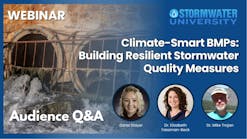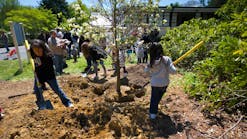About the author: Mary Beth Nevulis is managing editor of Storm Water Solutions. Nevulis can be reached at [email protected].
Mary Beth Nevulis
undefinedGreening The Nation
The outlook for growth in the storm water management industry—and green storm water infrastructure—is very good. But that growth largely relies on our leaders having the political will to make the investments necessary to solve our increasingly severe storm
water problems.
One of the strongest positive signs is the anticipated release in 2013 of the U.S. Environmental Protection Agency (EPA) proposed national rulemaking to strengthen the storm water program. This is a game changer that would establish regulations for storm water capture for new development and redevelopment of sites across the U.S. This rule will increase the demand for green infrastructure, and by developing national performance standards, it also would make it easier to train and certify workers with skills that can be transferable from one city to another.
Cities across the U.S. already are embracing integrated infrastructure strategies where traditional and green infrastructure work hand in hand to address storm water issues. Green infrastructure will not supplant traditional infrastructure, but instead be a part of integrated approaches that are more cost effective and provide additional benefits. Sewer districts and public utilities also will capture broader support for the investments they need to make by incorporating green infrastructure, which provides co-benefits like increased open space, improved air quality, increased property values, neighborhood beautification and economic development. The fact that green infrastructure now is viewed as a legitimate strategy for addressing storm water issues is a confirmation of the success of green infrastructure advocates.
Many green infrastructure projects will face the challenge of having a visible presence in the communities in which they are adopted. Neglecting the upkeep and functionality of these systems can create opposition to theirimplementation. Lack of funding and a qualified workforce to maintain green storm water infrastructure will require the development of innovative partnerships to properly care for this infrastructure. Aside from these concerns, the employment and business opportunities for underrepresented communities in operations and maintenance are real and represent an opportunity for industry growth.
Sustainable Solutions
Over the past several years, sustainability has become a major buzzword in all areas of the economic and political environment. Storm water quality management is a field that needs to fully embrace and understand this concept in the years ahead.
Perhaps the most critical aspect of sustainability is the long-term maintenance and operation of any storm water treatment practice—proprietary or non-proprietary. If any storm water management solution neglects to address these issues, its efficacy will be compromised and a non-sustainable situation will be created.
The stakeholders in the storm water management industry need to be cognizant of the impact of their decisions going forward, as they are likely to impact our water quality efforts for decades. There is a rational balance between economic and environmental concerns that must be developed to achieve sustainability in storm water management.
The increasing trend toward mandating use of land-based non-proprietary solutions should be alarming. Whereas on the surface a “green” installation appears to be an eco-friendly solution, the long-term maintenance needs of these solutions are largely being ignored, and in some cases, other practices have the potential to provide more effective treatment at lower lifecycle cost. Such instances have begun to result in significantly decreased water quality mitigation, as well as much higher capital replacement costs and more frequent maintenance than had been anticipated. Neither the environment nor the consumer can derive any benefit in these cases—a prime example of a non-sustainable solution.
All industry stakeholders are encouraged to increase the focus on the implementation and enforcement of credible long-term maintenance and operation of all storm water management facilities. This is the only way we are going to achieve the goals of improving the water quality in our lakes, rivers and oceans.
The Stormwater Equipment Manufacturers Assn. is committed to creating a sustainable storm water management industry that delivers this rational balance between economic and environmental concernsthrough the implementation of all available storm water treatment technologies and processes to ensure their long-term efficacy.
New Protocol, New Potential
The evolution of storm water management policies, technology and implementation has gone into hyperdrive in recent years. The Chesapeake Bay lawsuit was the primary factor in compelling this shift. The settlement prompted the finalization of the first multi-state total maximum daily load for the Chesapeake Bay, as well as a renewed commitment to pursue and finalize a national storm water rule, and there should be no mistaking that the near future for watershed managers and state and local government officials will include new responsibilities and accountability for improving the nation’s water supply.
The question for local officials of “who” is going to pay for these improvements has shifted dramatically to “how are we” going to pay for them. That said, the challenges are how to: reduce costs through greater efficiencies; reduce risks, such that the investment of financial capital is encouraged; and encourage innovation through incentives for new solutions and strategies. These questions remain because the “new” science of storm water management is increasingly complex, and very few companies and financial institutions are eager to get their feet wet (no pun intended).
The Commonwealth of Virginia is developing a new testing and performance verification protocol, the Virginia Technology Assessment Protocol (VTAP), for manufactured storm water treatment devices. The VTAP was approved by the Virginia Soil & Water Conservation Board in December 2012. The protocol was developed by a panel of experts and vetted by a chartered BMP Clearinghouse Committee, and should serve to provide a stable platform upon which to bring a new storm water treatment device to market. The testing parameters currently include total phosphorus and sediment, and there are plans to expand the protocol to include total nitrogen, and eventually bacteria and other targeted pollutants. As expected, given the complexity of the science, the protocol is very thorough and requires significant investment on the part of manufacturers. Comprehensive monitoring on real development sites through a reliable data verification and approval process is needed in order to ensure reliable and long-term performance to satisfy the need for accountability in achieving the ambitious goals of clean water.
Manufacturers should embrace this process for its potential. The overall demand for innovative and cost-effective storm water treatment solutions will continue to increase as more state and local regulators recognize the cost of not leveraging good research. Looking forward, with the VTAP in play, there are realistic and significant opportunities for innovation and product development.
Water As A Resource
Major trends and drivers for water resources and storm water will be floods and droughts, regulatory trends in integrated storm water and wastewater permitting, and, to a lesser extent, development and redevelopment depending on location.
On the redevelopment side, some cities like Detroit and Cleveland have programs to demolish abandoned homes, which is opening up opportunities for green infrastructure, parks and greenways, and city modernization. In terms of drought, we need to focus on conservation, planning ahead and using water wisely. For floods, proper floodplain management and flow controls for detention for the full range of hydrology are critical. One key is to find creative ways to turn flooding problems into water resource opportunities with storage, recharging, ecosystem hydrology and floodplain restoration. So floods and droughts also can create opportunities for synergistic storm water and water resource solutions.
There is some real common sense in the EPA initiatives for integrated storm water and wastewater NPDES permitting within existing regulations. Previously, these were looked at separately. The new integrated approach saves money and provides the greatest environmental benefits. This is something that has been emerging within the EPA, and many hope that it will come to pass even within the current regulatory structure. Occasionally a well-intended regulation can get in the way of a cost-effective solution, and this is a good opportunity for the regulations to work to provide the lowest cost and best benefit for the clients, cities and counties, and state agencies.
The key to the future is to consider storm water and wastewater as resources, not drainage or disposal items. Figuring out how to turn these into a resource is our best chance for a sustainable future.
Download: Here





